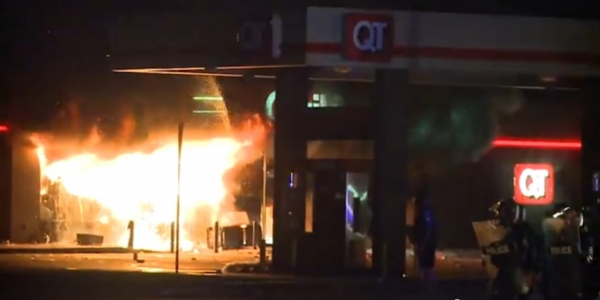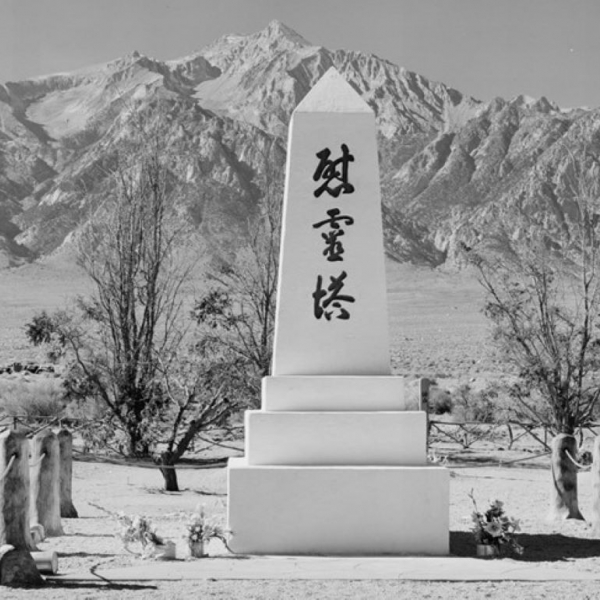Abundant video and photography captured the destruction of the Ferguson QuikTrip after looters set it on fire, and the images allowed for rapid development of a narrative of disorder and lawlessness. The QuickTrip's fiery undoing was not made by media, yet its transmission made a certain public narrative inexorable. Yet the looting's hidden transcript emerged soon after: the looting and arson was essentially a case of mistaken identity, which revealed the cultural doubling of street stories (which erroneously held the QuikTrip to be the site of Michael Brown's possible shoplifting) and media narratives (which transformed the dying store into the punctum of a narrative about the protests). The remaining charred store, which visually could confirm the disparate paired narratives while evidentially disputing both, encapsulated the disconnect between interpersonal and media narratives.
Dorian Johnson, eyewitness to Brown's death, posted a YouTube video that foreshadowed the looting. The cameraperson, present in the video only as an inquisitor's voice, wonders about the infamous cigarillos: "They say he stole them from Quick Trip." On camera, Johnson conclusively debunks the rumors: "Dude was at the Ferguson Market bro, next to the McDonald's." Again, the disconnect between media -- some outlets referenced the video before the fire -- and hearsay on the ground -- which persistently spread the rumor of QuikTrip employees "snitching" on Brown -- is evident. Johnson's video either never reached or failed to influence whoever set the QuikTrip ablaze, despite its circulation (and Johnson's own words to friends). At 11:08 p.m. on August 10, Michael Skolnik reported via Twitter: "The QuickTrip is now burning."
Scenes of the robust flames roaring out of the QuikTrip served as simile for other cultural memories of unrest. Arson has been part of the landscape of American racial unrest for centuries. The QuikTrip's destruction at the hands of its own supposed customers -- an assertion that was later proved specious after the looters seemed less likely to be Ferguson residents -- became visually joined to the 1992 South Central Los Angeles, 1965 Watts and 1967 Detroit riots. Those events, which reached Americans through televised imagery of broken store windows, smoldering shop fronts and seeming pandemonium, introduced Americans to what Dolores Hayden describes as "the spectacle of urban people setting fire to their own landscape."
Fire served as a potent symbol of ascribed self-immolation, and prompted relational depictions of the QuikTrip event and historic riots in largely black neighborhoods. Coverage of the QuikTrip looting also emphasized the illicit acts and omitting efforts by others to quell the looting. One week later, amid looting at other businesses, Antonio French poignantly described a young man running into the Ferguson Market and Liquor Store to put out a newly-set fire with a bottle of soda. Visual media did not broadcast this or other stories, and in fact lessened coverage of Ferguson events when they started breaking the nearly-mythic narrative established by earlier riots. Also absent was comparison of the QuikTrip blaze to St. Louis' only actual riot in which buildings were destroyed -- the 1917 riots in East St. Louis, in which whites set large parts of the city on fire while wantonly killing black residents.
Instead, media placed an inordinate emphasis on the future of QuickTrip itself, with television reporters immediately asking whether the store would be rebuilt or protected. Amid the social disturbance in Ferguson, rebuilding a single convenience store and gas station to many people seemed an insignificant detail, but it resonated among reporters. There was more press coverage of QuikTrip's deliberations about rebuilding than of St. Louis County Prosecutor Robert McCulloch's convening of a grand jury to consider charging Officer Darren Wilson, whose identity was still cloaked. QuikTrip spokesperson Mike Thornbrugh told the St. Louis Business Journal on August 11 plainly, "[w]ith all due respect, there's nothing left to protect." QuikTrip instead focused on offering counseling to the employees who had been hiding in a storeroom during the looting, and only eventually fenced the site and removed gasoline on August 19.
sources
"Gas station destroyed in Ferguson riot"
Unglesbee, Ben. "QuickTrip coming to grips with destruction of Ferguson store"
Photo Credit: Screen capture from YouTube video (source: https://www.youtube.com/watch?v=gVGKGEdiZC8 The QuikTrip store quietly burns after a crowd looted the store on August 10, 2014.





